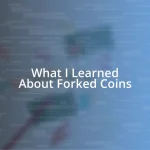Key takeaways:
- Bitcoin faces significant challenges, including volatility, environmental concerns, and scalability issues that hinder widespread adoption.
- Exploring alternative cryptocurrencies, such as Ethereum and Cardano, highlights innovations that address Bitcoin’s limitations and prioritize sustainability.
- Making informed investment decisions requires understanding market dynamics, evaluating personal risk tolerance, and staying updated on project fundamentals to avoid impulsive choices.

Understanding Bitcoin and Its Challenges
Bitcoin, as a pioneer in the cryptocurrency space, has undoubtedly revolutionized how we think about money, but it isn’t without its hurdles. Personally, I’ve watched friends become disillusioned when they faced the volatility; it’s like riding a rollercoaster without a safety harness. Is the potential for massive gains worth the risk of steep losses?
Then there’s the environmental concern that looms large. I remember a conversation with a fellow crypto enthusiast who shared his frustration over Bitcoin mining’s energy consumption. It’s hard to ignore that while we chase innovation, we also have a responsibility to our planet. Isn’t it time we reconcile our quest for digital currency with sustainable practices?
Finally, Bitcoin’s scalability issues present another challenge. Just think about those times during peak transaction periods when fees skyrocketed. I’ve seen people hesitate to use Bitcoin for everyday purchases when a $5 coffee could end up costing them $10 in fees. This raises a vital question: how can we expect widespread adoption if the system can’t handle the demand?

Exploring Alternative Cryptocurrencies
Exploring alternative cryptocurrencies has opened my eyes to a variety of options that address some of Bitcoin’s limitations. For instance, when I first heard of Ethereum, I was intrigued by its smart contracts capability, which allows for self-executing agreements without intermediaries. This innovation not only enhances transaction efficiency but also spurred a whole ecosystem of decentralized applications, inspiring me to think about the future of technology in finance.
Here are a few notable alternatives worth considering:
- Ethereum (ETH): Known for its smart contract functionality.
- Ripple (XRP): Focused on enabling faster and cost-effective international payments.
- Cardano (ADA): Highlights sustainability and a proof-of-stake mechanism.
- Litecoin (LTC): Offers faster transactions compared to Bitcoin.
- Polkadot (DOT): Aims to enable different blockchains to interoperate seamlessly.
I remember diving into a community discussion about Cardano and its emphasis on research-driven development. It sparked an important realization for me: not all cryptocurrencies are just about quick profits; some are genuinely addressing real-world issues, like sustainability and scalability. It’s refreshing to see projects that prioritize ethical practices while still harnessing the power of blockchain technology. This exploration shows that the crypto landscape is constantly evolving, providing options that resonate more closely with my values.

Evaluating Risks and Rewards
Evaluating risks and rewards in the realm of cryptocurrency is essential for making informed decisions. As I navigated this space, I often felt like a tightrope walker, balancing the potential for significant gains against the weight of potential losses. The thrill of witnessing a sudden price surge can easily cloud judgment, making it crucial to stay grounded. After all, I’ve seen friends lose considerable amounts due to overlooking market trends—it’s a reminder that what goes up can also come crashing down.
Moreover, environmental factors and technological sustainability weigh heavily in my considerations. I vividly recall a discussion where someone pointed out that while diversifying my portfolio may mitigate financial risk, the underlying technology’s impact on the environment can’t be ignored. This gave me pause; as I explore alternatives, I often ask myself whether I’m supporting a future that aligns with sustainability. Shouldn’t our investments reflect our values, especially when the technology could shape tomorrow’s world?
Finally, risk management strategies also play a vital role in assessing rewards in this landscape. I took some time to adopt a more cautious approach after experiencing a major market dip. Using tools like stop-loss orders helped me feel more secure, ultimately leading to better outcomes. It’s clear that learning to navigate volatility is part of growing in this space—one foot on solid ground while the other tiptoes into uncertainty.
| Cryptocurrency | Risks | Rewards |
|---|---|---|
| Ethereum (ETH) | Smart contract vulnerabilities and high gas fees | Potential for groundbreaking decentralized applications |
| Ripple (XRP) | Regulatory scrutiny and dependence on network adoption | Fast, low-cost international payments |
| Cardano (ADA) | Long development timelines and competition | Sustainable, research-focused technology |
| Litecoin (LTC) | Market saturation and lower adoption rates | Faster transactions and established credibility |
| Polkadot (DOT) | Complex technical dynamics | Interoperability between blockchains |

Practical Tips for Investing
When it comes to investing in cryptocurrencies, diversification is your best friend. I learned this lesson the hard way when I put all my eggs in one basket and watched the market shift unexpectedly. Spreading your investment across several alternatives not only mitigates risks but also opens doors to various opportunities. It’s like creating a safety net; while one investment may stumble, another could soar, balancing your overall portfolio.
Setting clear investment goals can significantly shape your strategy. I recall a time when I jumped into a trending cryptocurrency without a plan, simply swayed by the buzz. That enthusiasm taught me that defining what I want to achieve—whether it’s long-term growth or short-term gains—helps guide my choices and keeps me aligned with my financial objectives. It’s one of those moments where I thought, “What do I really want from this investment?” Having that clarity turned out to be invaluable.
Finally, always stay informed about the projects behind the currencies you invest in. I often find myself deep-diving into whitepapers and project outlines before making any buying decisions. One thing I’ve noticed is that staying updated not only gives me a clearer picture of the market but also enhances my confidence in what I own. If I can’t explain a project’s fundamentals or why I believe in its potential, I reconsider my involvement. It’s about investing with purpose, rather than being swept away by hype. Wouldn’t you want your investments to reflect meaningful insights rather than mere speculation?

Future Trends in Cryptocurrency Alternatives
The future of cryptocurrency alternatives is undoubtedly fascinating. I’ve noticed a gradual shift towards environmentally friendly options, which resonates with those of us who are more sustainability-minded. For instance, I recently stumbled upon a project focusing on carbon-neutral mining practices. It made me think, “Are we really paving the way for a greener future with our investments?” This trend reflects a broader societal movement where cryptocurrencies may prioritize reflecting our values alongside profitability.
Looking ahead, I see a surge in community-driven tokens aimed at promoting cooperative economic models. In my experience, participating in a community-based project was not just about financial gains; it fostered a sense of belonging and shared purpose. I clearly remember the excitement of discussing project goals with fellow enthusiasts, feeling like we were part of something bigger. Could these alternatives redefine our understanding of ownership in the digital age?
Moreover, I can’t ignore the rapid advancements in decentralized finance (DeFi) platforms, challenging traditional banking systems. An innovative approach I encountered recently allowed me to lend and earn interest on my crypto assets without any intermediaries. It sparked a thought — if this trend continues, will we be seeing the end of conventional banking as we know it? As I reflect on these developments, it becomes clear that the excitement around cryptocurrency alternatives lies in their potential to revolutionize our financial landscape, making it more inclusive and accessible for everyone.

Making Informed Investment Decisions
Making informed investment decisions in the cryptocurrency space is crucial for anyone looking to navigate this volatile market. I remember a time when I simply glanced at prices rather than doing my research. That impulsive decision led to losses I could have avoided if I had taken the time to analyze the fundamentals of the projects I was investing in. In hindsight, I realized that understanding what drives a cryptocurrency’s value can be the difference between success and failure.
It’s also important to consider your risk tolerance. I’ve encountered moments when my excitement led me to invest in emerging cryptocurrencies that were high-risk. Reflecting on those experiences, I’ve learned that it’s essential to evaluate how much uncertainty I can comfortably accept. What’s my threshold for market fluctuations? This self-awareness helps me approach investments with a more grounded perspective, allowing me to make choices that align with my financial stability.
Moreover, keeping a close eye on market trends can guide my investment decisions. For instance, tracking sentiment on social media platforms has often given me early signals about potential shifts. I cannot stress enough how valuable it is to blend both qualitative and quantitative data in my analysis. Being attuned to the market’s pulse has helped me pivot when necessary, reinforcing the idea that informed decision-making is a continuous process, not a one-time event. How do you keep informed about your investments? I’ve found that sharing insights and learning from others can be incredibly beneficial.













